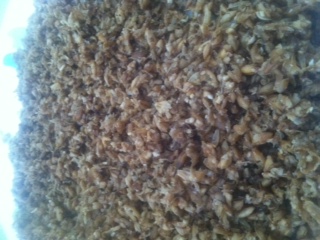OptimusJay
Well-Known Member
I have low mash efficiency and am trying to narrow down the most likely reason and I think it may be the grain crush.
I batch sparge.
Equipment:
10 gal orange HD cooler with a 36" SS braided hose.
Most recent grain bill:
3 lbs Marris Otter
3 lbs 2 row
1.5 lbs Munich
.5 lb C60
.5 Honey Malt
I fill the cooler with 140F water to get it warmed up, and let it sit for 30 minutes or so.
Empty that water then add about half of the strike water, pour in the grains, add the remaining strike water, and stir for probably 3 minutes.
Mash temp was 152. 45 minutes into the hour long mash i opened the cooler and stir again for probably 2 minutes then put the lid back on and let it sit for another 15 minutes. I follow use the Beersmith suggested 1.25 quarts/lb grain.
From here, I stir once more, maybe for another minute, let sit for a minute or so, then collect the cloudy first couple of quarts of wort and gently pour back into the mash cooler. I collect the first runnings. Next I add the sparge water (175F), stir again, let sit for a minute or so, collect the cloudy runnings, pour that back into the mash cooler and collect the second runnings until empty.
For the above grain bill I was targeting collecting 3.5 gallons of wort, and that is what I collected. However, the target SG based on 70 (or maybe 72%) mash efficiency was 1064 and I got 1050. I used a refractometer initially with the warm wort, then also cooled a sample to 65F and used my hydrometer. It read 1050.
After much reading on this section of the forum I am thinking that the crush size might be the reason for the low efficiency. Does my mash/sparge procedure look legit? I get my grain milled at the home brew store, maybe its time to look into purchasing my own mill? All opinions and feedback are appreciated.
Thanks,
Jay
I batch sparge.
Equipment:
10 gal orange HD cooler with a 36" SS braided hose.
Most recent grain bill:
3 lbs Marris Otter
3 lbs 2 row
1.5 lbs Munich
.5 lb C60
.5 Honey Malt
I fill the cooler with 140F water to get it warmed up, and let it sit for 30 minutes or so.
Empty that water then add about half of the strike water, pour in the grains, add the remaining strike water, and stir for probably 3 minutes.
Mash temp was 152. 45 minutes into the hour long mash i opened the cooler and stir again for probably 2 minutes then put the lid back on and let it sit for another 15 minutes. I follow use the Beersmith suggested 1.25 quarts/lb grain.
From here, I stir once more, maybe for another minute, let sit for a minute or so, then collect the cloudy first couple of quarts of wort and gently pour back into the mash cooler. I collect the first runnings. Next I add the sparge water (175F), stir again, let sit for a minute or so, collect the cloudy runnings, pour that back into the mash cooler and collect the second runnings until empty.
For the above grain bill I was targeting collecting 3.5 gallons of wort, and that is what I collected. However, the target SG based on 70 (or maybe 72%) mash efficiency was 1064 and I got 1050. I used a refractometer initially with the warm wort, then also cooled a sample to 65F and used my hydrometer. It read 1050.
After much reading on this section of the forum I am thinking that the crush size might be the reason for the low efficiency. Does my mash/sparge procedure look legit? I get my grain milled at the home brew store, maybe its time to look into purchasing my own mill? All opinions and feedback are appreciated.
Thanks,
Jay






